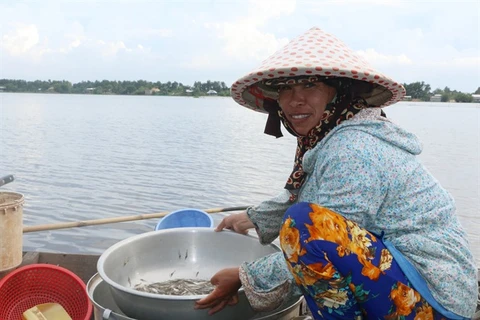Kien Giang (VNA) – The Mekong Delta region’s rice farming area in the 2018-2019 winter-spring crop is 1.57 million hectares, with production being expected at about 7 tonnes per hectares, but the region is forecast to face drought and salinity, especially in coastal areas.
According to the Department of Cultivation under the Ministry of Agriculture and Rural Development, the El Nino-Southern Oscillation, which brings about abnormal wind and sea level, is likely to switch into El Nino in early 2019.
Meanwhile, the rainy season in the southern area may end earlier than the average time in many years. Therefore, coastal areas of the Mekong Delta region are likely to suffer from drought and salt water intrusion during the crop, with affected rice areas being about 100,000 hectares.
To cope with the situation, the department advised regional localities to reserve water for the crop, and sow rice between October 2018 and early January 2019. The localities should use high quality and resilient rice varieties such as OM 4900, OM 7347, OM 6976, OM 4218, OM 5451, and Jasmine 85, according to the department.
Coastal areas should cultivate extra short-term varieties with strong resilience amidst severe drought, while choosing right cultivation time to avoid salinity.
Meanwhile, the region should focus on upgrading major canal systems and reinforcing dykes.
Localities should give guidelines to local farmers on the sowing time and choosing of varieties, while keeping a close eye at weather developments and designing responding plans, the department asked.-VNA
According to the Department of Cultivation under the Ministry of Agriculture and Rural Development, the El Nino-Southern Oscillation, which brings about abnormal wind and sea level, is likely to switch into El Nino in early 2019.
Meanwhile, the rainy season in the southern area may end earlier than the average time in many years. Therefore, coastal areas of the Mekong Delta region are likely to suffer from drought and salt water intrusion during the crop, with affected rice areas being about 100,000 hectares.
To cope with the situation, the department advised regional localities to reserve water for the crop, and sow rice between October 2018 and early January 2019. The localities should use high quality and resilient rice varieties such as OM 4900, OM 7347, OM 6976, OM 4218, OM 5451, and Jasmine 85, according to the department.
Coastal areas should cultivate extra short-term varieties with strong resilience amidst severe drought, while choosing right cultivation time to avoid salinity.
Meanwhile, the region should focus on upgrading major canal systems and reinforcing dykes.
Localities should give guidelines to local farmers on the sowing time and choosing of varieties, while keeping a close eye at weather developments and designing responding plans, the department asked.-VNA
VNA
























